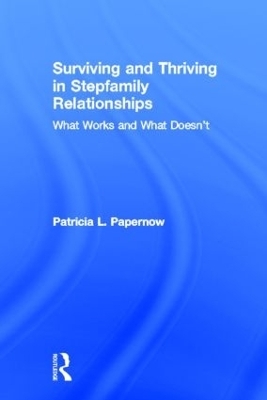
Surviving and Thriving in Stepfamily Relationships
Routledge (Verlag)
978-0-415-89437-1 (ISBN)
Surviving and Thriving in Stepfamily Relationships draws on current research, a wide variety of clinical modalities, and thirty years of clinical work with stepfamily members to describe the special challenges stepfamilies face. The book presents the concept of "stepfamily architecture" and the five challenges it creates, and delineates three different levels of strategies—psychoeducation, building interpersonal skills, and intrapsychic work—for meeting those challenges in dozens of different settings.
The model is designed to be useful both to stepfamily members themselves and to a wide variety of practitioners, from a highly trained clinician who needs to know how and when to work on all three levels, to a school counselor or clergy person who may work on the first two levels but refer out for level three. It will also be useful to educators, judges, mediators, lawyers and medical personnel who will practice on the first level, but need to understand the other two to guide their work.
Patricia L. Papernow, EdD, is a nationally recognized expert on stepfamilies, couples in "blended family" systems, and parenting after divorce. She also provides training and consultation throughout the US. Since 1981, she has been in private practice focusing on clinical supervision, and individual and couple therapy with adults.
The Families Key to Genograms List of Figures Acknowledgements Part I: Laying the Foundation for Stepfamily Architecture 1. A Map for Stepfamilies 2. What Makes Stepfamilies Different? Part II: The Five Challenges 3. The First Challenge: Insider/Outsider Positions are Intense and Stuck 4. The Second Challenge: Children Struggle With Losses, Loyalty Binds, and Too Much Change 5. The Third Challenge: Parenting Tasks Polarize the Adults 6. The Fourth Challenge: Creating a New Family Culture 7. The Fifth Challenge: Ex-Spouses are Part of the Family Part III: Four "Diverse" Stepfamilies 8. Stepfamilies Headed by Lesbian and Gay Couples 9. African American Stepfamilies: Strengths We Can Learn From 10. The Challenges for Latino Stepfamilies 11. New Wrinkles: Later Life Cycle Stepfamilies Part IV: Stepfamilies Over Time 12. The Stepfamily Cycle: Normal Stages of Stepfamily Development 13. Six Patterns of Becoming a Stepfamily Part V: Helping Stepfamilies Thrive 14. Level I: A Tool Box for Psychoeducation 15. Level II: A Tool Box for Interpersonal Skills 16. Level III: A Tool Box for Intrapsychic Work Becoming a Stepfamily is a Process, Not an Event Working with Stepfamily Members Over Time Conclusion Endnotes References
| Erscheint lt. Verlag | 10.7.2013 |
|---|---|
| Zusatzinfo | 1 Tables, black and white; 27 Line drawings, black and white |
| Verlagsort | London |
| Sprache | englisch |
| Maße | 152 x 229 mm |
| Gewicht | 453 g |
| Themenwelt | Sachbuch/Ratgeber ► Gesundheit / Leben / Psychologie ► Familie / Erziehung |
| Sachbuch/Ratgeber ► Gesundheit / Leben / Psychologie ► Partnerschaft / Sexualität | |
| Geisteswissenschaften ► Psychologie ► Familien- / Systemische Therapie | |
| Geisteswissenschaften ► Psychologie ► Klinische Psychologie | |
| Medizin / Pharmazie ► Medizinische Fachgebiete ► Psychiatrie / Psychotherapie | |
| Sozialwissenschaften ► Pädagogik ► Sozialpädagogik | |
| Sozialwissenschaften ► Soziologie | |
| ISBN-10 | 0-415-89437-9 / 0415894379 |
| ISBN-13 | 978-0-415-89437-1 / 9780415894371 |
| Zustand | Neuware |
| Haben Sie eine Frage zum Produkt? |
aus dem Bereich


